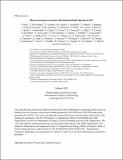Physics of runaway electrons with Shattered Pellet Injection at JET
Author(s)
Reux, C.; Paz-Soldan, C.; Eidietis, N.; Lehnen, M.; Aleynikov, P.; Silburn, S.; Bandaru, V.; Ficker, O.; Hoelzl, M.; Hollmann, E.M.; Jachmich, S.; Joffrin, E.; Lomas, P.J.; Rimini, F.; Baylor, L.; Bleasdale, A.; Calacci, L.; Causa, F.; Carnevale, D.; Coffey, I.; Craven, D.; Dal Molin, A.; de la Luna, E.; De Tommasi, G.; Garcia, J.; Gebhart, T.; Giacomelli, L.; Huber, A.; Khilkevich, E.; Lowry, C.; Macusova, E.; Manzanares, A.; Nocente, M.; Panontin, E.; Papp, G.; Pautasso, G.; Peacock, A.; Plyusnin, V.; Shevelev, A.; Shiraki, D.; Commariva, C.; Sozzi, C.; Sridhar, S.; Sweeney, Ryan; Szepesi, G.; Tinguely, R. Alex; Wilson, J.; JET contributors; ... Show more Show less
Download22ja051_full.pdf (1.196Mb)
Metadata
Show full item recordAbstract
Runaway electrons created during tokamak disruptions pose a threat to a reliable operation of future larger machines. Experiments using Shattered Pellet Injection (SPI) have been carried out at the JET tokamak to investigate ways to prevent their generation or suppress them if avoidance is not sufficient. Avoidance is possible if the SPI contains a sufficiently low fraction of high-Z material, or if it is red early in advance of a disruption prone to runaway generation. These results are consistent with previous similar fi ndings obtained with Massive Gas Injection. Suppression of an already accelerated beam is not efficient using High-Z material, but deuterium leads to harmless terminations without heat loads. This effect is the combination of a large MHD instability scattering runaway electrons on a large area and the absence of runaway regeneration during the subsequent current collapse thanks to the flushing of high-Z impurities from the runaway companion plasma. This effect also works in situations where the runaway beam moves upwards and undergoes scraping-off on the wall.
Description
Submitted for publication in Plasma Physics and Controlled Fusion
Date issued
2022-02Department
Massachusetts Institute of Technology. Plasma Science and Fusion CenterJournal
Plasma Physics and Controlled Fusion
Publisher
IOP
Other identifiers
22ja051